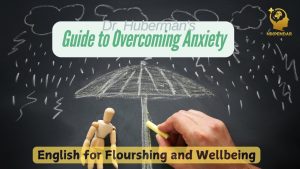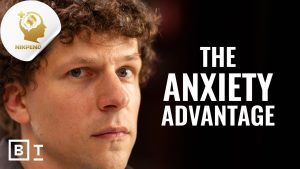
Beginner
Task: Describe a Simple Way to Feel Calm
Imagine you are talking to a friend who feels a little stressed. Using simple words, explain one easy way to feel calmer. Think about how breathing can help.
- Prompt Questions:
- What makes people feel stressed? (e.g., too much work, not enough sleep)
- What is one thing the speaker says helps with stress very quickly? (Hint: It involves breathing!)
- How does this special breath work? (Focus on the double inhale and long exhale).
- When can you use this technique? (e.g., when you feel stressed, in line at the bank)
Intermediate
Task: Explain the Physiological Sigh and Its Benefits
You are giving a short presentation to a group about simple ways to manage stress. Explain what the “physiological sigh” is and why it’s a good tool for reducing stress.
Prompt Questions:
-
- What is the “physiological sigh”? Describe the breathing pattern.
- How does the physiological sigh affect your body and heart rate? (Mention the diaphragm, lungs, and carbon dioxide).
- Why is this technique considered a “real-time” tool for stress reduction?
- What are some situations where you could use the physiological sigh?
- Compare the physiological sigh to other stress reduction methods mentioned (e.g., meditation, exercise, breath work). What makes it unique?
Advanced
Task: Discuss the Neuroscience Behind Stress Reduction and Voluntary Control
You are a guest on a podcast discussing cutting-edge research in neuroscience and stress management. Elaborate on the physiological mechanisms behind the body’s stress response and how voluntary control of the autonomic nervous system, particularly through the physiological sigh, offers an immediate pathway to reduce stress.
Prompt Questions:
-
- Detail the relationship between the brain, body, and heart in the stress response. How do sympathetic and parasympathetic nervous systems interact with breathing?
- Explain the role of the diaphragm, sinoatrial node, and lung alveoli in regulating heart rate and carbon dioxide levels during a physiological sigh.
- Discuss the concept of “top-down mechanisms” versus “hard-wired physiological pathways” in stress control. Why is the latter more effective in real-time high-stress situations?
- Analyze the speaker’s claim that the physiological sigh “bypasses a very important feature of how we function, which is that it’s very hard to control the mind with the mind.”
- Reflect on the implications of this research for individuals and broader public health strategies regarding stress management.
Beginner
Task 1: Listen and Identify Key Words
Instructions: Listen to the audio. As you listen, circle or write down the words you hear from the list below. Some words might appear more than once.
Word List:
-
- stress
- body
- sleep
- heart
- breathe
- inhale
- exhale
- calm
- fast
- slow
Task 2: True or False?
Instructions: Listen to the audio. Read the statements below and decide if they are True or False.
-
- Exercise is good for us. (True/False)
- When you inhale, your heart beats slower. (True/False)
- When you exhale, your heart beats faster. (True/False)
- The physiological sigh is a way to reduce stress quickly. (True/False)
- You can control your diaphragm. (True/False)
Intermediate
Task 1: Fill in the Blanks
Instructions: Listen to the audio. Fill in the missing words in the sentences below.
-
- Mindfulness and meditation are good, and ____________ is good for us.
- The ____________ system is a name given to the general features of alertness or calmness.
- When you ____________, your heart starts beating faster.
- If you want your heart to beat faster, ____________ longer than your exhales.
- If you want to slow your heart rate down, make your ____________ longer.
- The physiological sigh involves a double ____________ and a long ____________.
Task 2: Short Answer Questions
Instructions: Listen to the audio. Answer the following questions in one or two sentences.
-
- What is one common thing people have heard is good for them, besides exercise and sleep?
- What does the speaker say is the “fastest hard-wired way” to eliminate a stressful response?
- What happens to your heart when you inhale?
- What happens to your heart when you exhale?
- When do humans and animals naturally do the physiological sigh?
Advanced
Task 1: Summarize Key Concepts
Instructions: Listen to the audio. In your own words, summarize the speaker’s main points about stress reduction. Include the following:
-
- The role of the autonomic nervous system.
- How inhaling and exhaling affect heart rate.
- The specific technique called the “physiological sigh” and why it’s effective.
- The benefits of using these “real-time tools” for stress.
Task 2: Critical Thinking Questions
Instructions: Listen to the audio. Answer the following questions, providing details from the transcript to support your answers.
-
- The speaker distinguishes between “top-down mechanisms” and “physiological tools.” Explain the difference and why physiological tools are highlighted as more effective in real-time stress.
- Describe the physiological process that occurs during an inhale and how it impacts heart rate, referencing the diaphragm and sinoatrial node.
- Explain the unique mechanism of the physiological sigh (double inhale, long exhale) and why it’s specifically effective at reducing carbon dioxide and promoting relaxation.
- Discuss why the speaker emphasizes that these techniques “require no learning” in the moment, despite having to be taught initially. What does this imply about their accessibility during high-stress situations?
Beginner
Task: Identify Key Concepts
Instructions: Read the text and find the answers to the following questions. You don’t need to understand every word, just try to find the main idea for each question.
- What is one quick way the speaker says we can reduce stress in our body?
- What is the name of the breathing technique that helps calm us down?
- When you inhale, what happens to your heart? Does it get bigger or smaller?
- When you exhale, what happens to your heart? Does it get bigger or smaller?
- What happens in our lungs when we do a “double inhale”?
Intermediate
Task: Summarize and Explain
Instructions: Read the text carefully. Then, answer the questions below in your own words.
- According to the speaker, what is the “physiological sigh” and how is it different from general “breathwork”?
- Explain the relationship between inhaling, the diaphragm, and heart rate. How does a longer inhale affect your heart rate?
- Explain the relationship between exhaling, the diaphragm, and heart rate. How does a longer exhale affect your heart rate?
- Why is the physiological sigh considered a “real-time” tool for stress reduction, and what benefit does this offer compared to other stress-reducing practices?
- What role does carbon dioxide play in feeling agitated, and how does the physiological sigh help to relieve this?
Advanced
Task: Analyze, Synthesize, and Evaluate
Instructions: Read the text critically, paying attention to details and underlying arguments. Then, respond to the prompts with comprehensive answers, drawing evidence from the text and synthesizing information.
- The speaker distinguishes between “top-down mechanisms” and “physiological interventions” for stress reduction. Elaborate on this distinction, providing examples of each and explaining why the speaker prioritizes the latter in certain situations.
- Describe in detail the physiological mechanism of the “physiological sigh.” Include how it affects the diaphragm, the heart’s sinoatrial node, blood flow, and ultimately the nervous system’s response to stress.
- Discuss the speaker’s argument for why the physiological sigh is considered “the fastest hard-wired way” to eliminate a stressful response. What scientific evidence or physiological principles does he reference to support this claim?
- Analyze the speaker’s comparison between the physiological sigh and “breathwork.” What are the key differences, and what unique advantages does the physiological sigh offer according to the speaker?
- The speaker mentions that controlling the mind with the mind can be challenging during heightened states of activation. How does the physiological sigh bypass this challenge, and what implications does this have for practical stress management?
Beginner
Task: My Favorite Way to Relax
You just learned about a special breathing technique called the “physiological sigh” that can help you calm down quickly. Think about a time when you felt stressed or worried.
In 3-5 sentences, describe:
- What made you feel stressed?
- What did you usually do to try and feel better?
- Based on what you learned, how could the “physiological sigh” help you in that situation? (Remember, it’s a double inhale and a long exhale.)
Intermediate
Task: Understanding the Physiological Sigh
The speaker explains how our breathing directly affects our heart rate and stress levels. They introduce the “physiological sigh” as a powerful tool.
Write a short paragraph (5-7 sentences) explaining:
- How does inhaling affect your heart rate?
- How does exhaling affect your heart rate?
- What is the “physiological sigh” (describe the breathing pattern)?
- Why is the physiological sigh considered a fast and effective way to reduce stress in real time?
Advanced
Task: The Autonomic Nervous System and Real-Time Stress Reduction
The transcript delves into the scientific basis of stress reduction through breathing, specifically highlighting the role of the autonomic nervous system and the physiological sigh.
Write an essay (approximately 150-200 words) that addresses the following:
- Explain the concept of the autonomic nervous system and its connection to alertness and calmness.
- Discuss the speaker’s argument that “top-down mechanisms of intention and gratitude” are difficult to use during heightened stress, and how the physiological sigh bypasses this challenge.
- Describe the physiological mechanism of how the physiological sigh works, referencing the diaphragm, heart rate, and carbon dioxide levels.
- Elaborate on why this technique is presented as a superior “real-time” tool for stress reduction compared to other practices like general “breathwork.”





